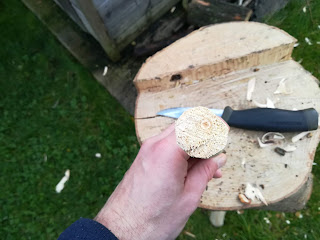I decided to resurrect this blog, mainly because I wanted to write up some bushcraft experiences and it seemed easier to use this old blog rather than create something new.
I do various online courses offered by
Paul Kirtley, and in a recent video he challenged his students to try bow drill with two woods that they have not succeeded with previously. Since I've only ever tried Willow (success), Lime (success) and Hazel (fail), then there are plenty of options for me.
I've done both of those woods several times, and have succeeded with them in the last few months. I have also failed this year with Willow - a good lesson that if you don't keep honing these skills you can lose them.
On a regular walk I noticed what I believe to be Grey Poplar, so I thought that's a good starting point. It's pretty similar to Willow in many respects and so should not be too difficult.
I made up the set after referencing Dan Hume's book
The Art of Fire for some pointers. He is very specific about dimensions and so I thought I would follow what he has to say and see where it got me. I have practiced bow drill a fair bit, but my success is certainly not as high as I would like it to be.
He mentions a hearth depth of 2cm, a spindle width of 2.5cm and a spindle height of about 25cm. After my attempts I would say 25cm is a good starting place for burning in the set, but is probably a little long for me when trying to get the ember. By the time I get to that stage though, the spindle will have reduced due to reshaping the top point.
The set at the start of the process, with a slightly too long spindle. The bearing block is green ivy - the bow is one I made a while ago - I don't see any point in remaking that bit each time.
I was a little worried about the weak pith on the spindle I had selected (see image below), but the pith was off centre at the top point (just visible in the previous image) so I thought I might get away with it.
The wood seemed to be pretty effective and it wasn't too hard to burn in the set once I had reduced the spindle length down to a little below 25cm. I was feeling confident.
So this is where reality set in and I struggled, despite plenty of smoke and ash. I think the main areas I need to show focus are:
- Position - small adjustments here can make a big difference to ensure that the larger muscles in the shoulder and back are activated without tiring the bowing arm
- Also small adjustments in position can ensure the arm holding the bearing block does not require an undue expenditure of effort to hold the block in place. I have not quite mastered using body weight to bear down on the block rather than brute strength
- Recarving the hole in the bearing block to be quite shallow to reduce friction - this made a big difference. The hole can develop sides after a few attempts which catch the top of the spindle
I had to give up on day one because I ran out of energy.
Day Two
I really felt my set was a good one and that the materials were also very good, so the next day I got the set out again and gave it another try. Attempt one was close but no cigar. Attempt two was a success.
Being fresh helped but there were minor adjustments that also helped:
- Tightening the cord a bit - I had experienced a little slippage
- Reshaping the groove - the bowl had moved slightly and so the groove was no longer centred properly
- I did not use ash that had previously been created - I wonder if this makes the set less effective? No idea
- Positional adjustments that I think really helped to recruit the correct muscles
This is very much an ongoing process! I now have three woods under my belt though which is awesome. Next stop any of alder, sycamore or pine.






















